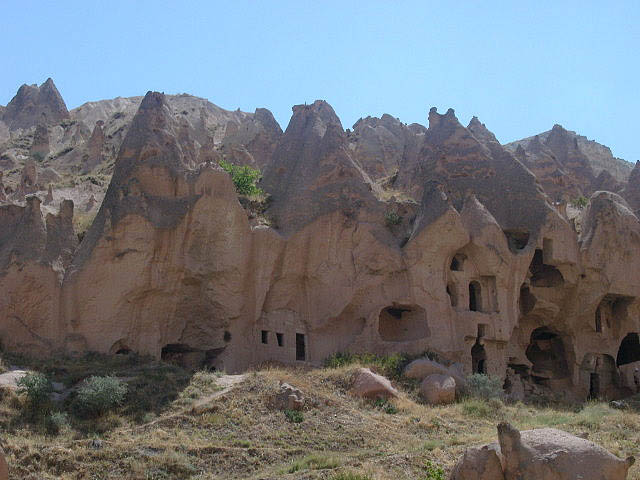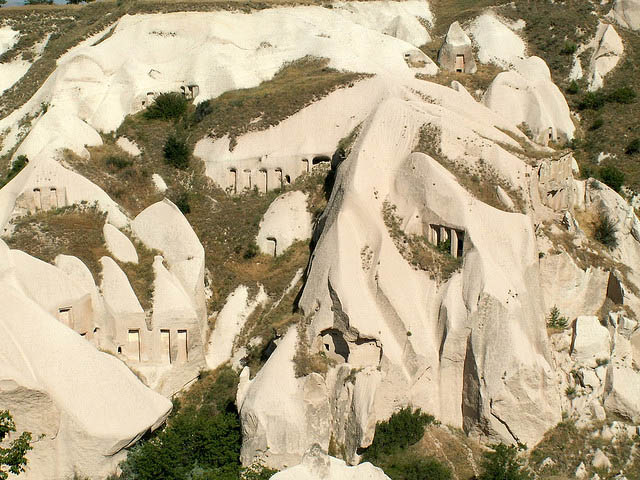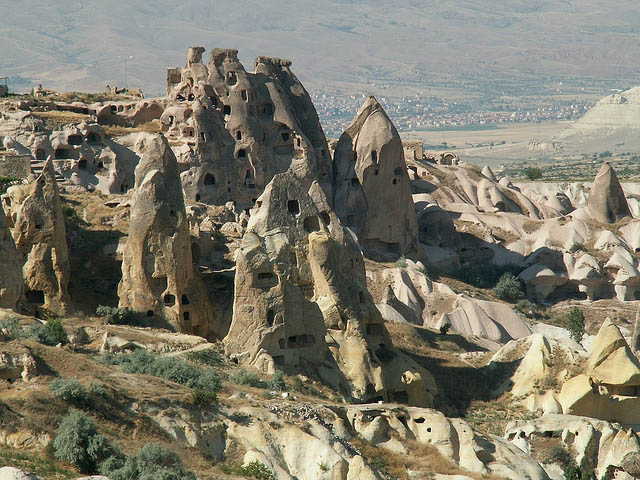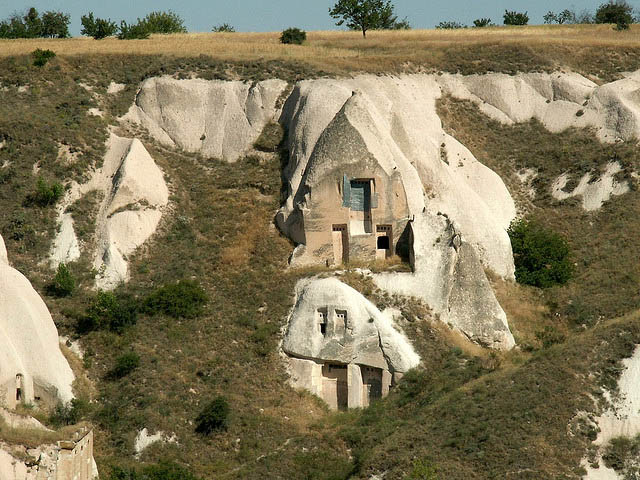It's 2am and outside it looks like Mars. I've just been jolted awake from an airport transfer doze. A huge full moon hangs low in the sky illuminating the white, softly curving hills, pockmarked by abandoned cave dwellings. Vast conical pillar formations cluster in the lee of a hillside, while surreal shapes, blasted by wind and rain, are silhouetted against a narrow canyon of pink basalt.
 |
| Houses Troglodytes |
The taxi lurches up a steep road to our cave hotel, the House of Wishes, built into the top of a huge craggy boulder - the highest point in the village of Urgup. I head bedward and gaze up to admire my cave room with its beautifully proportioned arched ceiling carved from the rock, supported by natural, rough hewn walls traced with fine lines of ochre yellow sulphur. Windows overlook a little patio out front, while a sleek bathroom of chrome, porcelain and stone is built into the bulbous rear of the cave.
The bizarre landscape of Cappadocia National Park in central Turkey was formed millions of years ago by three mighty volcanic eruptions. Mineral-rich rock, lava and white ash spewed across 15,000 square miles and, when mixed with floodwaters, formed a hard, sunbaked hide known as tufa. This coating has gradually been eroded by the elements to create peculiar geological formations that now draw gaping crowds to the central Anatolian plateau.
People have been carving cave homes out of the landscape here for 10,000 years. Gradually abandoned over the last century, many cave houses are now being bought by affluent Turks and foreign buyers who are painstakingly converting them into chic boutique hotels, second homes and self-catering properties. Many of the cave dwellings nestle within the villages of Urgup, Uchisar and Goreme, which form the points of a triangle containing the area's main tourist sites. The villages are all about an hour's drive from the nearest airport at Kayseri and hiring a guide with a car is an advantage. I'm always a bit earthquake-nervous when visiting Turkey or Greece, so was relieved to hear my cheery guide, Bunyamin, tell me that Cappadocia is built on solid foundations and has been untroubled by seismic activity for 9,000 years, which explains why many of the troglodyte dwellings have endured.
First we visit the valley of Goreme - a geological freak show - which holds the most concentrated collection of cave dwellings and strange rock formations in the area. I wander through Pasa Bagi, meaning 'Fairy Chimneys Valley', where there are 50 or more natural conical pillars topped with a flat cap of rock, resembling pawns on a giant chess board. Nearby, the Derbent or 'Pink' Valley has its own collection of fairy chimneys, set alongside huge, pastel pink and toffee-coloured boulders. We drive on to Goreme open air museum, a monastic complex carved out of the tufa by early Christians fleeing Roman persecution. There are numerous rock-hewn churches and chapels whose interior walls are lined with exquisite Byzantine paintings dating from around 1100AD, depicting a mix of scenes from the Bible with Greek inscriptions alongside primitive pagan, Catholic and Jewish imagery. Protected from the light, the soft-hued natural pigments are as sharp as when freshly applied.
A few miles on is the hilltop town of Uchisar, built around a huge rocky outcrop with far-reaching views across the park. Sheer cliff walls drop into a narrow gorge, its floor traced with white pathways. We visit at sunset when the bulbous sun-bleached tufa formations, protruding like giant bubbles from between the rock, turn a soft, blush pink. All around us specially trained birds loop the loop on the thermals, while a muezzin calls through crackling speakers.
While these landscapes are certainly awe-inspiring as you negotiate them on foot, an even better way to marvel at the valley is on a sunrise balloon flight. Kapadokya Balloons escorted me into the heavens, dropping low into the canyons for close-ups of the rock formations, before gently floating up to around 2,000ft for big sky panoramics. From up here, it's easy to spot the snow-capped Mount Erciyes, one of the ancient volcanos that created this region. It rises high above Cappadocia's wheat-covered plains, valleys and tabletop mountains - a golden-hued landscape slashed with emerald green groves of poplars, acacia and walnut. It is up here that you discover how extensive the honeycomb effect of human excavation has been. Post-flight, we celebrate with a champagne breakfast in a meadow knee-deep in blue cornflowers, red poppies and wild grasses.
But in Cappadocia the real surprises are below ground. It is not just the cave homes that are getting a makeover. Abandoned subterranean villages, once used to store crops and to escape marauding hordes, from the ancient Hittites to Mongols, Greeks and Romans, are also being unearthed and reopened to visitors.
The underground city of Kaymakli, first dug out by the Hittites in 1200BC, has been partially excavated. It's a labyrinth of interconnecting tunnels leading to stables, storage rooms, dining areas, a winery and a tiny chapel. About 33 metres deep, it was home to the local community during times of invasion; all exits would be sealed using huge millstones that rolled snugly into carved crevices.
Today, bare lightbulbs are strung throughout the excavated areas, but the black waxy residue of linseed candles used before the advent of electricity scar every wall. At one point, a strong breeze marks a shaft, with hand and foot holds carved into its walls, that plummets 40 metres to the black depths of the deepest cavern. Fortunately, you can stay in cave dwellings in considerably more style these days.
 |
| Fairy Chimneys |
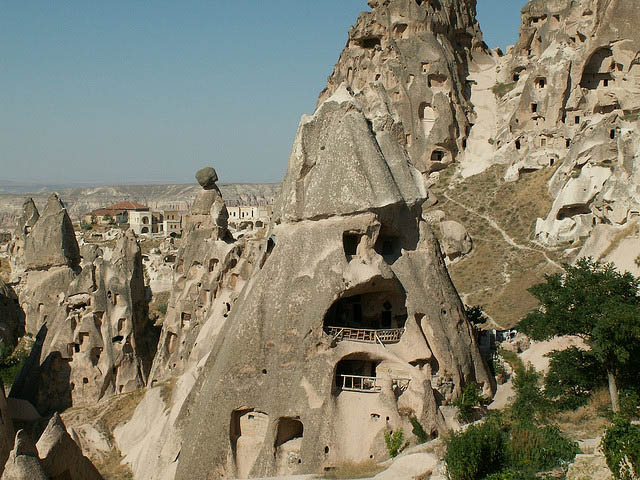 |
| Lunar Landscape, Houses Troglodytes |
Text source:- Wikipedia. Images are copyrighted by their owners. Found any copyright issue, contact the administrator immediately. Report it now!
You have read this article Asia /
Houses /
Turkey
with the title Troglodyte Houses Turkey. You can bookmark this page URL https://tiffanyeatworld.blogspot.com/2011/12/troglodyte-houses-turkey.html. Thanks!









